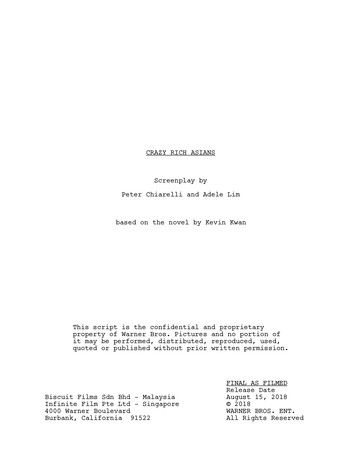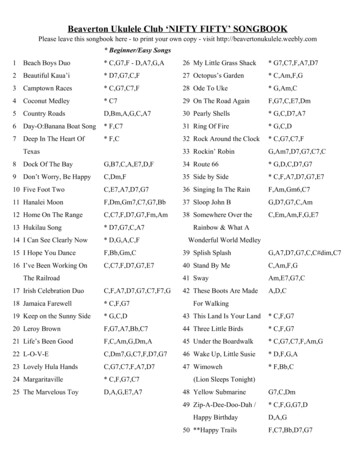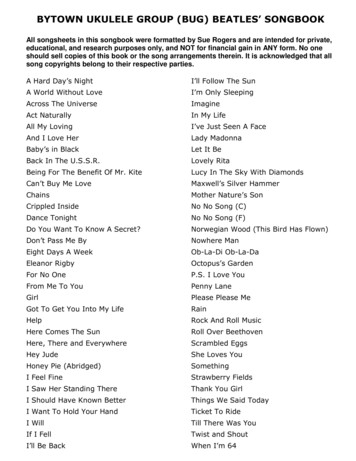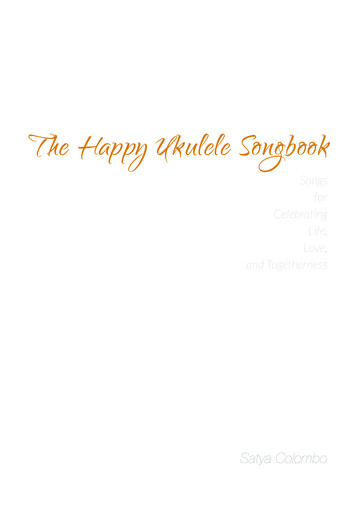
Transcription
Ukulele Crazy!Get your Uke on!Play your Mahalowith the modern-DayMaster of ukulele,Bartt WarburtonEntire contents copyright 2012 Bartt Warburton. No reproduction without express prior written consent.
2You’re headed towards ukulele glory!I’m Bartt Warburton, and I’m going to teach you how toplay ukulele. This e-book is the companion to the MahaloDVD that’s called “Ukulele Crazy: Get Your Uke On!”Both the e-book and the DVD are for beginners, so if youjust got your first ukulele, you’re in the right place. Youcan get the DVD from mahalo-ukulele.com, or you candownload a digital version at Bartt.net. I’ll be teachingyou how to play basic chords, do basic strumming, andhow to read those funny-looking chord diagrams. I’ll alsoteach you some of the basic vocabulary of music, andwe’ll do a little bit of blues and some practice exercises.With the help of “Ukulele Crazy,” you’ll be able to playlots of easy songs. When you’ve mastered everything inthis book, go to Bartt.net and get more advanced lessons.And when you’re ready to shop for an ukulele, go toMahalo!Get your ukeout, and getyour uke on!www.mahalo-ukulele.comEntire contents copyright 2012 Bartt Warburton. No reproduction without express prior written consent.
3Before we start, a quick wordabout Mahalo & BarttMahalo is most popular ukulele in the world. Mahalo is known for theirwonderfully crazy designs, like the Smiley Face and Alien ukes. Buddingmusicians across the globe make Mahalo their first instrument, because ofthe affordability and durability of Mahalo starter ukes. And they come inlots of fun colors.Mahalo also makes higher-quality instruments for more advanced players. For example, Bartt canbe seen playing his adorable LTD3, a concert-sized uke built from spalted flame maple and solidred cedar, with abalone inlays. Each Mahalo ukulele is given strict inspection at every step of thebuilding process. Mahalo listens to their customers, and creates new designs and modificationsbased on their suggestions. They are proud to say that even the lowest-priced ukulele gets allthe care and passion needed for serious fun. To discover their wild designs, go to http://www.mahalo-ukulele.com and check things out!Bartt Warburton is recognized around the world for his dazzling musical performances and“Fancy Fingers” workshops. Known as “Ukulele Bartt,” the Los Angeles Times calls him a “modernday master.” In addition to his eclectic and fearless playing virtuosity, he is equally acclaimed forbeing as much fun as you can have with four strings.Honored as “Teacher of the Year” in the 40,000-teacher Los Angeles Unified School District,America’s second-largest district, Bartt has also been awarded a commendation from the mayorof Los Angeles. He has produced many instructional videos, e-books, and music CDs, includinghis first DVD and companion e-book, “Ukulele Bartt’s Ultimate Ukulele.” All of them can befound across North America, Europe, Australia, New Zealand, and Asia. Bartt is the creator ofthe popular website, Bartt.net, a bountiful resource center for players of all skill levels. Millionsof viewers have enjoyed his Internet videos. In addition to his vigorous performing schedule,Bartt also keeps himself busy as a recording engineer in his Los Angeles studio.“Ukulele Crazy: Get Your Uke On,” is a video/e-book set that brings Mahalo and Bartt togetherin a beginner-level instructional course for players across the globe. The “Ukulele Crazy” videois available in English, Japanese, Chinese, Spanish, and French!Entire contents copyright 2012 Bartt Warburton. No reproduction without express prior written consent.
4Chapter 1Know Your Parts:The Anatomy of an UkuleleHEADSTOCKMACHINE HEADSNUTPOSTSFRETSFINGERBOARDBINDINGROSETTESOUND HOLESADDLEBRIDGEEntire contents copyright 2012 Bartt Warburton. No reproduction without express prior written consent.
5Want a little more info?Keep reading:The “frets” are the thin metal strips that run across the fingerboard every inch or so. They markthe places where you put your fingers. The word “fret” also refers to the spaces between thesemetal strips. Your finger goes on the wooden fingerboard, not the metal fret.The “posts” are the metal things that stick up from the headstock. You wrap the strings aroundthe posts, which are attached to the tuning pegs. When you turn the knob on the tuning peg, thepost rotates, tightening or loosening the strings.“Binding” is the decorative stuff that goes around the body. It is sometimes called “purfling.” Not allukes have binding. The “rosette” is decorative, too. It goes around the “sound hole” on some ukes.The “saddle” and the “nut” are small pieces of wood, bone, or other material. They are virtuallythe only parts of the uke that actually touch the strings, and therefore have a lot to do with howyour uke sounds. They have tiny grooves in them, where the strings rest. This helps to keep thestrings stable and in tune.The “machine heads”, also known as “tuning pegs”, are the knobs at the top of your uke. They’realso called “tuners.” You turn them, to tighten or loosen the strings. That’s how you keep youruke in tune. There are “friction” tuners and “geared” tuners. “Geared” tuners have little gearsinside of them, which keep the peg from getting loose. So when you tune up, the strings stay intune. “Friction” pegs do not have gears. They are simply pegs that turn. They generally work fine,but when they’re old, they have a tendency to loosen a little, making it a bit harder to keep youruke in tune. But the good part is, they cost less.Tuners come in various ratios, such as 12:1 or 6:1. The bigger number refers to the number oftimes you have to turn the peg during tuning, before you get to the next note. The bigger thenumber, the higher the ratio, and the more accurately you can tune your uke. But a higher ratioalso means that it takes longer to unwind your strings when you change them. The higher theratio, the more expensive they can get.Entire contents copyright 2012 Bartt Warburton. No reproduction without express prior written consent.
6Chapter 2Holding the UkuleleHere are the important things to knowThe “sound hole” should face your audience. Don’t point the sound hole at yourself, the sky,or the floor. The sound comes out of this hole, so turn the ukulele towards your audience if youwant them to hear you.Basic Finger Position: If you are right-handed, you will form chords with your left hand, andstrum with your right hand. If you are left-handed, of course you will form chords with your righthand and strum with your left hand. In either case, the hand that you use to form chords is calledyour “fingering hand.” The other hand is called the “strumming hand.”Keep the fingers of your fingering hand perpendicular to the neck. Push down on the stringyou want to use, but do not let that finger touch the other strings. One string per finger! If yourfinger accidentally dips down and gently touches the string below, you will get a muffled note,sometimes called a “dead” note. That’s bad. Play each note cleanly!Basic Thumb Position: The thumb of your fingering hand should rest on the back of the neck.Don’t let it peek up above the neck. By resting your thumb on the back of the neck, you areallowing your fingers to reach further. This will help you to press down on the strings more easilyand cleanly.Strumming-Hand Position: Your strumming hand should be relaxed. Don’t tense your muscles!Rotate your wrist as you strum across all four strings. You should usually strum at the placewhere the ukulele’s body joins the neck. You can also strum directly over the sound hole, but it isusually more natural to strum a little bit higher up the neck.Entire contents copyright 2012 Bartt Warburton. No reproduction without express prior written consent.
7Chapter 3Tuning the UkuleleWhether you tune with an electronic tuner, a pitch-pipe, or by ear, you must know about “top”and “bottom” strings before you begin tuning.The “top” string is the string furthest from your nose, when you’re in playing position. It is called“top,” because it is the highest-sounding string. Its location, however, is actually at the bottomthe fingerboard. This string is commonly called the “first” string.Conversely, the “bottom” string is the one closest to your nose when you’re in playing position. Itis physically located at the top of the fingerboard, but it is the lowest-sounding string. This stringis commonly called the “fourth” string.NOTE: Ukuleles can be strung with a “High-G,” or a “Low-G” string. In other words, the G-stringcan be in a high octave, or in a low octave. That’s why some ukes sound deeper than others.There is no particular reason to string either way, other than personal preference. You play bothof them the same way. The High-G sounds a little more gentle, and the Low-G is slightly morereminiscent of a deeper guitar sound. You can experiment and try both styles. But in both cases,the G-string is known as the “bottom” string. So when you are tuning your “top” string, you aretuning your A-string. When you tune your “bottom” string, you are tuning your G-string.There are other tunings, but we will stick to G-C-E-A in this book. Most countries use GCEAtuning. In Canada and some other countries, however, ukulele players frequently tune to DGBE.But we’ll get to that some other day, in some other book.Tuning with an Electronic TunerGet an electronic tuner. It is also known as a “clip-on” tuner,because it clips on to your instrument. Clip it onto the headstockof your uke, and turn it on. The face of the tuner will light up, anda needle or other indictor will begin to move. Turn the tuning pegof the G-string until the tuner indicates that you have hit a G-note.Presto, your G-string is in tune! Now repeat this for the C, E and Astrings. I told you it was easy!Entire contents copyright 2012 Bartt Warburton. No reproduction without express prior written consent.
8NOTE: If you turn a tuning peg too far, your tuner will scroll through the other notes as youraise the pitch. You may accidentally tune beyond the note you’re aiming for. For example, ifyou’re aiming for a G-note, and you tighten the peg too high, you will move beyond the G-note.If you continue to tighten the peg, eventually you will reach the G-note that is in a higher octave.You will also probably break the string! The strings should not be too tight, nor should they betoo loose. Pay attention to the tension of your strings when they are correctly in tune, and youwill learn to recognize when you’ve tuned beyond your intended note.Tuning with a Pitch-PipeA pitch-pipe is a little pipe that you blow into. It’s like a tiny fourpiped flute that plays four different notes. You blow into the G,listen to the sound, and turn your tuning peg until your stringmatches the sound. Then repeat this for the other three strings.You need a good ear for this tool, but after you’ve been playingfor a few months, your ear will begin to recognize the tones.Tuning By EarI don’t mean to let you down, but I’m not going to explain ear-tuning. It’s difficult for beginners,it takes a long time to master, and virtually every player uses an electronic tuner anyway. It isabsolutely an extremely important part of being a musician, but this is a beginner book. You shouldbe having fun, instead of getting frustrated. Tuning by ear can frustrate a beginner, and make youwant to put the instrument down and do something else. But if you get an electronic tuner, youcan tune in about one minute. Learn ear-tuning after you get more familiar with your instrument.Traditionalists will jeer at my approach, but I’m not afraid to use technology. Are you?Stretching and changing the stringsNew ukuleles go out of tune every few minutes. Butafter a few weeks of playing, they will stay in tune. Andwhenever you change your strings, they will go out oftune for a couple of weeks. That’s because the stringshave been wound up in a little bag at the factory, andthey need to stretch out.It’s easy to stretch your strings. Just grab them andyank on them. Then tune them back up, and repeat. Dothis about a dozen times, then repeat it every half-houror so. Eventually your strings will be stretched out, andthey will stay in tune.Stretch your strings! They’repretty hard to break, so go for it!How often should you change your strings? It depends on how frequently you play. If you are aprofessional player, you might change them every month or two. But if you were a professionalplayer, you wouldn’t be reading this book. Casual players might change their strings once peryear. Some ukuleles hanging on my wall have had the same strings for two years. Maybe you’llchange them every few months. Strings are inexpensive, so try different brands. Your instrumentcan have many different sounds and feels, depending on what brand of strings you use. It makesa big difference, so experiment with a variety of strings.Entire contents copyright 2012 Bartt Warburton. No reproduction without express prior written consent.
9Chapter 4What is a “Chord,” and what is a “Note?”A “note” is a single tone. Pluck one string, and you’re playing a “note.”A “chord” is any combination of two or more “notes.”So if you pluck two strings simultaneously, you are playing a “chord.” A chord, therefore, is madeup of a combination of notes. Any combination will make a chord. Of course, some chords soundbetter than others. But even if you pluck two discordant notes simultaneously, and make anawful, annoying sound, you are still playing a “chord.” It’s just an ugly chord. Maybe it’s better tostick with the beautiful chords, unless you’re writing a song about fingernails screeching acrossa blackboard.MAHALO INVASION!Bartt autographs a whole bunch of Mahalo’s in New ZealandEntire contents copyright 2012 Bartt Warburton. No reproduction without express prior written consent.
10CChapter 5How to Read Chord Diagrams3Here’s an explanation of what those lines and dots mean.Look for thr
“Ukulele Crazy: Get Your Uke On,” is a video/e-book set that brings Mahalo and Bartt together in a beginner-level instructional course for players across the globe. The “Ukulele Crazy” video is available in English, Japanese, Chinese, Spanish, and French! ntire contents copyright 2012 Bartt Warburton o reproduction without epress prior written consent 4 Chapter 1 Know Your Parts: The .











